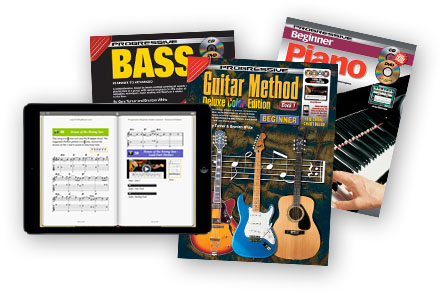<< First < Previous | Intro 1 2 3 4 5 | Next > Last >>
Back to Table of Contents
Understanding the Drumkit
Before you begin playing the drums, it is important to know what the different parts of the drumkit are called. The following photo shows a common basic setup. This kit contains three tom toms, but many drummers use only two as these are probably the least necessary part of the kit. In fact, most drum parts can be played using only the snare drum, the bass drum and the hi hat cymbals, so don’t worry if you have a very basic setup. The bass drum is played with the right foot and produces what is often called the “bottom end” sound of the drums. The snare drum is usually played with the left hand, but the right hand is also used for certain beats as well as playing fills.
The hi hat and ride cymbals are generally played with the right hand, but once again the left hand may be used in certain situations. The crash cymbal may be played with either hand, depending on which is most practical for each musical situation. The tom toms (toms for short) can also be played by either hand. The hi hat cymbals can also be played by the left foot while certain sounds using the open hi hats are achieved by using a combination of the right hand and the left foot. As you can see, becoming a good drummer requires the use of all four limbs. Through the course of this book you will be introduced to all of the sounds mentioned here and by the end you should be confident playing in a band in most styles of music.
How to Sit At the Drums
The most important aspect of sitting at the drums is to keep your back straight. This gives you maximum reach and avoids the possibility of muscle strains. Start by sitting with the snare drum directly in front of you. The exact distance is a personal choice, experiment until you feel comfortable with the position of both the drum stool and the snare drum.
When setting up the position of the drum stool and the kit, make sure you can reach all the drums and cymbals easily without having to lean. Also make sure that everything is far apart enough that you are not in a cramped position. The most important thing is to be in a relaxed and comfortable position when you are playing.
How to Hold the Drumsticks
There are two basic ways of holding the drum sticks, one is called traditional grip and the other is match grip. In traditional grip, each hand holds the stick differently. This grip evolved out of marching band snare drum playing where the snare drum is held to one side. However, this method has no practical advantage when applied to the modern drumkit. For beginning drummers it is more practical to use match grip which means that both hands hold the sticks the same way in the manner shown:
How to Read Drum Music
Drum music is commonly written on the Stave or Staff. This is made up of five lines and four spaces.
The Staff is divided into sections with Bar Lines.
Each section between the Bar lines is called one bar or one measure.
A Final Bar Line indicates the end of the music.
Two Dots next to a double bar line are called a repeat sign and indicate that the music is to be repeated from the beginning, or from a previous repeat sign.
Here is another sign called a Bar Repeat Sign which indicates that the previous bar is to be repeated. If the same bar is to be played several times in succession, repeat signs are often used.
The percussion clef sign is used at the beginning of each line of drum music.
The Time Signature appears next to the Bass Clef Sign and indicates how many beats are to be played in each bar and what type of notes these beats represent. The time signature shown here is the four four time signature which indicates four quarter note beats per bar.
Drum music is usually written in the spaces of the staff, including the space above the staff, to represent different parts of the drum kit. The most commonly used method is shown below.
<< First < Previous | Intro 1 2 3 4 5 | Next > Last >>
Back to Table of Contents








































